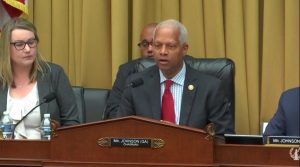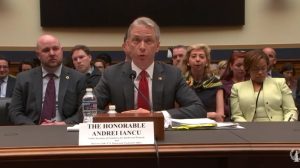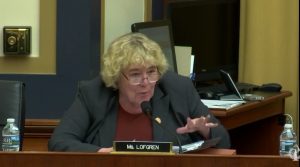“’I believe [Section 101] is the most important substantive issue of patent law right now,’ Iancu said, ‘and I believe all branches of government need to work on this.’”
Last week, the House Committee on the Judiciary’s Subcommittee on Courts, Intellectual Property, and the Internet convened a hearing to perform oversight of the U.S. Patent and Trademark Office. USPTO Andrei Iancu fielded questions on Section 101 patent eligibility issues and fraudulent trademark application filings and, while several Representatives on the subcommittee noted Director Iancu’s procedural changes at the Patent Trial and Appeal Board (PTAB), much of the previous backlash to those changes seemed to have dissipated.
Leadership Highlights PTAB, Small Business, and Section 101
In his opening statement, Representative Hank Johnson (D-GA), Chairman of the House IP Subcommittee, discussed the impact that issued patents have on small businesses, noting that the first patent granted to a startup results in the business both hiring an average of 16 employees and earning an average of $10.6 million in additional sales within five years. However, Johnson added that recent case law from the U.S. Supreme Court have resulted in major issues with patent eligibility under 35 U.S.C. § 101, threatening innovation in critical technology areas like medical diagnostics. He was also concerned by a rise in fraudulent trademark filings coming from China that can hurt American businesses trying to register legitimate marks.

Hank Johnson
Representative Martha Roby (R-AL), Ranking Member of the House IP Subcommittee, also lamented recent SCOTUS case law on Section 101 eligibility in her opening statement. She also discussed inter partes review (IPR) proceedings at the PTAB and said that, while IPRs were intended to be a cheaper and simpler alternative than the U.S. district courts for challenging a patent’s validity, “opponents of the PTAB argue that IPR proceedings make it too easy to invalidate a patent, pointing to high invalidation rates for patents that the agency agrees to review.” She also echoed Rep. Johnson’s concerns on fraudulent trademark filings and talked about counterfeit issues, citing an April memorandum from President Donald Trump to the U.S. Departments of Commerce, Justice and Homeland Security to investigate counterfeiting issues and provide recommendations on addressing the problem later this year.
Representatives Jerrold Nadler (D-NY), Chairman of the full House Judiciary Committee, and Doug Collins (R-GA), the full committee’s Ranking Member, also gave opening statements. Nadler discussed changes made by Director Iancu to PTAB proceedings and, while he questioned whether the USPTO had the rulemaking authority to make those changes, he suggested that Congress could legislate to grant the agency such authority. Collins’ remarks focused on issues of patent eligibility as well as the PTAB’s patent invalidation proceedings. “The Supreme Court has basically put us through… a tortured exercise and call on the courts and Congress to fix it,” Collins said, noting that he and other colleagues in both parties and both houses of Congress were working on drafting legislation on a better patent eligibility test. As for the PTAB, Collins noted that the high cost of invalidity proceedings there often posed a burden that small business patent owners can’t bear when harassed by companies with large resources who want to copy technologies. “The very thing we’re trying to avoid, we’re actually seemingly incentivizing,” he said.
Iancu Faces Questions on Fraudulent Trademarks from China
Director Iancu’s opening statement began with his thanks to Congress for extending the USPTO’s fee setting authority through passage of the SUCCESS Act. He added that, pursuant to that act, the agency was taking action to increase the innovation ecosystem to underrepresented classes. In discussing changes to PTAB trial procedures, such as claim construction and claim amendments, Iancu was “happy to report that we have implemented successful improvements in all of those areas.” He said that almost every patent examiner has been trained in the agency’s recently issued Section 101 patent eligibility guidance. “This is good news because the status quo ante prior to our recent guidance is no longer tenable,” he said. Iancu also briefly touched on the recent notice of proposed rulemaking requiring foreign trademark applicants to be represented by U.S.-licensed counsel and the agency’s recent hiring of a chief information officer in an effort to improve its technical infrastructure.

Andrei Iancu
Trademark filings from China were a major focus during the questioning period for multiple subcommittee members. Representative Andy Biggs (R-AZ) discussed a 12-fold increase in Chinese trademark applications since 2013 and noted that, in 2017, Chinese applications outpaced the combined applications coming from Canada, Germany and the United Kingdom. While the USPTO was encouraging trademark lawyers to report suspicious specimens of use, Iancu said that only about 60 such reports had been received by the agency. Iancu added that it was often difficult to detect fraudulent specimens that had been altered using programs like Photoshop. Biggs pushed back against this, talking about a recent meeting with a major retailer who gave examples of Chinese trademark applications where the specimens of use were clearly fraudulent. While Iancu said he was aware of some of those specimens and that mistakes were sometimes made, most fraudulent specimens were difficult to detect and the USPTO was looking into advanced training for trademark examiners as well as better software solutions for detecting suspicious specimens.
Also banging the drum on Chinese trademark applications was Representative Greg Stanton (D-AZ), who cited statistics showing that they had risen from 6,000 applications in 2014 up to nearly 58,000 applications in 2018. Stanton asked whether the USPTO had considered asking trademark applicants for additional supporting documentation for proof of use. Iancu noted that the office currently relies on affidavits submitted by applicants and while some applicants use their affidavits dishonestly, he wasn’t sure that submitting additional documentation was the proper approach, as it could increase the burden on trademark applicants acting in good faith.
Iancu: Section 101 “Most Substantive Issue of Patent Law”
Stanton then moved on to discuss Supreme Court jurisprudence on Section 101 patent eligibility and asked whether there was a way to fix the problem through legislation. “I believe this is the most important substantive issue of patent law right now,” Iancu said, “and I believe all branches of government need to work on this.” He noted that the statute on the basic threshold for patent eligibility hadn’t changed from the 1793 version penned by Thomas Jefferson and James Madison. While a legislative fix was possible, amending Section 101 is a complex issue that Iancu said Congress must be careful and deliberate in undertaking.
Although not a member of the House IP Subcommittee and thus unable to attend the day’s hearing, Representative Thomas Massie (R-KY) forwarded a question through subcommittee member Rep. Jim Jordan (R-OH) on why such a high percentage of patent claims were being invalidated at the PTAB if the USPTO was issuing valid claims. Iancu said that the 84% of patent claims that Massie said were being invalidated by the PTAB were for claims where proceedings have been instituted. When considering patents that are challenged but a validity trial isn’t instituted, Iancu said that the percentage of patent claims invalidated was in the 30% to 40% range. He added that federal courts invalidate about 35% of challenged patent claims and thus it wasn’t surprising that the PTAB overall would invalidate patent claims at about the same rate as federal courts.
Back to the Drug Patents Debate
Representative Zoe Lofgren (D-CA), who in a previous oversight hearing had heatedly challenged Director Iancu on changes he has since put in place at the PTAB, was much more even-handed during this hearing. Lofgren asked Iancu about the updated guidelines released this January for examining software patent applications for patentability under 35 U.S.C. § 112’s written description requirement. She argued that attention should also have been paid to life sciences patent applications, noting the grant of nearly 100 U.S. patents to failed biotech firm Theranos based on inventions that didn’t work in practice. She also asked Iancu about the percentage of time that patent examiners examine applications for compliance with all the patent statutes, including Sections 101, 102, 103 and 112. While Iancu didn’t have the percentage breakdown Lofgren was seeking, he did note that patent examiners working in tech center 1600 for biotechnology and organic inventions would receive updated training in June.

Zoe Lofgren
Representative Ben Cline (R-VA) brought the conversation around to the drug patent debate, which has been rolling through Congress in recent months, asking Iancu if he thought it was appropriate to grant patents for trivial advances in pharmaceuticals. Iancu said that it was never appropriate to issue patents for obvious variations of an existing invention, citing the nonobviousness requirements found in Section 103 of the U.S. patent code. While Cline decried the grant of 75 or more patents to a single drug product, Iancu noted that the new use of old drugs can be very innovative, citing the development of AZT as a treatment for HIV/AIDS after it failed as a cancer drug. Further, new information collected about a drug already being used to treat a condition could lead to innovation in the form of improved dosing that can make the drug more potent and reduce patient toxicity.
Iancu also touched on patent application pendency during questioning by Representative Mike Johnson (R-LA), who noted that patent offices in China and elsewhere were working to expedite their examination processes. Iancu said that the USPTO had targets of less than 24 months from patent application filing to patent issuance and less than 15 months for the first office action, the latter of which Iancu expected to accomplish in the very near term. He added that the agency had recently come to an agreement with the examiners’ union on a new plan that involves new systems of routing patent applications to examiners based on expertise.

![[IPWatchdog Logo]](https://ipwatchdog.com/wp-content/themes/IPWatchdog%20-%202023/assets/images/temp/logo-small@2x.png)

![[[Advertisement]]](https://ipwatchdog.com/wp-content/uploads/2024/04/Patent-Litigation-Masters-2024-banner-early-bird-ends-Apr-21-last-chance-938x313-1.jpeg)
![[Advertisement]](https://ipwatchdog.com/wp-content/uploads/2024/04/Patent-Litigation-Masters-2024-sidebar-early-bird-ends-Apr-21-last-chance-700x500-1.jpg)

![[Advertisement]](https://ipwatchdog.com/wp-content/uploads/2021/12/WEBINAR-336-x-280-px.png)
![[Advertisement]](https://ipwatchdog.com/wp-content/uploads/2021/12/2021-Patent-Practice-on-Demand-recorded-Feb-2021-336-x-280.jpg)
![[Advertisement]](https://ipwatchdog.com/wp-content/uploads/2021/12/Ad-4-The-Invent-Patent-System™.png)







Join the Discussion
One comment so far.
Night Writer
May 16, 2019 06:25 amJust look at the biggest contributors to the people on the subcommittee. It is SV corporations. There is no chance that any change to patent law is going to happen that strengthens patents.
I think the big corporations have it about where they want it now. Patents are close to junk and yet they can be used to harass or stop small companies.
101 is the free pass at the district court level if you can’t invalidate with IPRs. No way is it going to change with major disruption to the US economy precipitating the change.